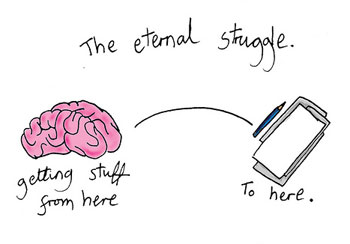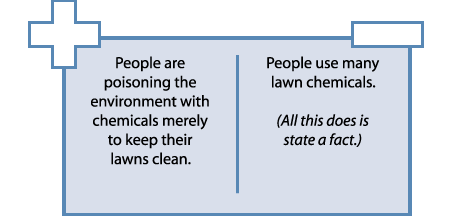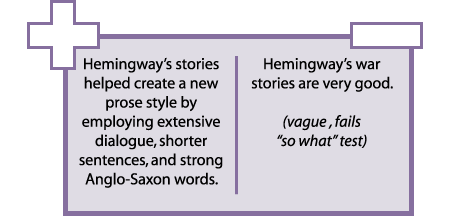So far we have discussed topics for a persuasive essay and explained how to narrow a topic using an essential question. Now we are going to further focus the topic by creating a thesis statement. In the thesis, you must state your position about your topic and answer the essential question in a complete sentence.
Here’s a simple example:
- Issue: daily starting times for high school
- Essential question: Should high school start later in the morning?
- Writer’s position: Yes, high school should start later.
- Working thesis statement: High school classes should begin later in the day.
When you know the issue and you figure out the essential question, then it’s easy to state your position and craft a thesis statement.

Source: “The Eternal Struggle,” Neil Slorance, Flickr
A good thesis statement declares what you believe and what you intend to prove. It is the difference between a thoughtful persuasive essay and a simple retelling of facts.
Characteristics of a Good
Thesis Statement
Here are some things to check off the list as you develop a thesis statement:
- It should be contestable and propose an arguable point with which people can reasonably disagree.
- It should be provocative; it takes a stand and justifies the discussion you will present.
- It tackles a subject that can be adequately covered in the assigned format. In other words, is the topic specific enough? If you have a two-page limit, for example, you need to choose a topic that can be covered in the allotted space and not a topic that needs eight pages to properly develop. A good thesis statement is specific and focused.
- It asserts your conclusion based on evidence. The evidence or support can include statistics, facts, text from a piece of literature, and more.
- It provides your readers with a map to guide them through your essay. They will know what your position is and will be able to follow the points in your essay.
- It also anticipates and refutes counterarguments.
As you develop a thesis statement, remember the following tips:
- Avoid vague language (i.e., “it seems”).
- Avoid the first person (“I believe” or “In my opinion”).
- Ensure that it passes the “So What?” or “Who Cares?” test—would your most honest friends ask you why they should care or respond with, “but everyone knows that?” For example, the statement, “People should avoid driving under the influence of alcohol,” would be unlikely to evoke any opposition and doesn't tell readers much. It's still more of a topic than a thesis. However, if you said, “People who drive drunk should have their licenses revoked after the first offense,” then you have developed a thesis that passes the “so what” test because this position will provoke readers to care.
You can also ask these questions to find out if a thesis statement is satisfactory. “Yes” should be the answer to each question.
- Is it contestable?
- Is it provocative (i.e., serving or tending to provoke, excite, or stimulate)?
- Is it specific enough for the assignment?
- Is it based on evidence or could you find evidence to support this position?
- Is your position clear to a reader?
Now try to apply what you have learned about a good thesis statement in the exercise below. Decide whether each numbered thesis statement is satisfactory by choosing “yes” or “no” from the pull-down menu. You can refer to the list above to help you decide. Note: Some statements are incomplete sentences but contain periods to avoid giving away the answers.
Once again, a good thesis statement doesn’t just state a fact or opinion. It asserts something.

A good thesis statement takes a stand rather than just announcing a subject.

A good thesis statement is the main idea, not the title. It must be a complete sentence that explains in some detail what will be in the essay.

A good thesis statement is specific rather than vague or general.

A good thesis statement has one main point rather than several main points. More than one point may be too difficult for the reader to understand or for the writer to support.

Remember, the purpose of persuasive writing is to convince an audience to think or act in a particular way. Effective persuasive writing presents an opinion and backs it up with sound reason. The sound reasons are the facts, statistics, or textual evidence that lend authority to your position.